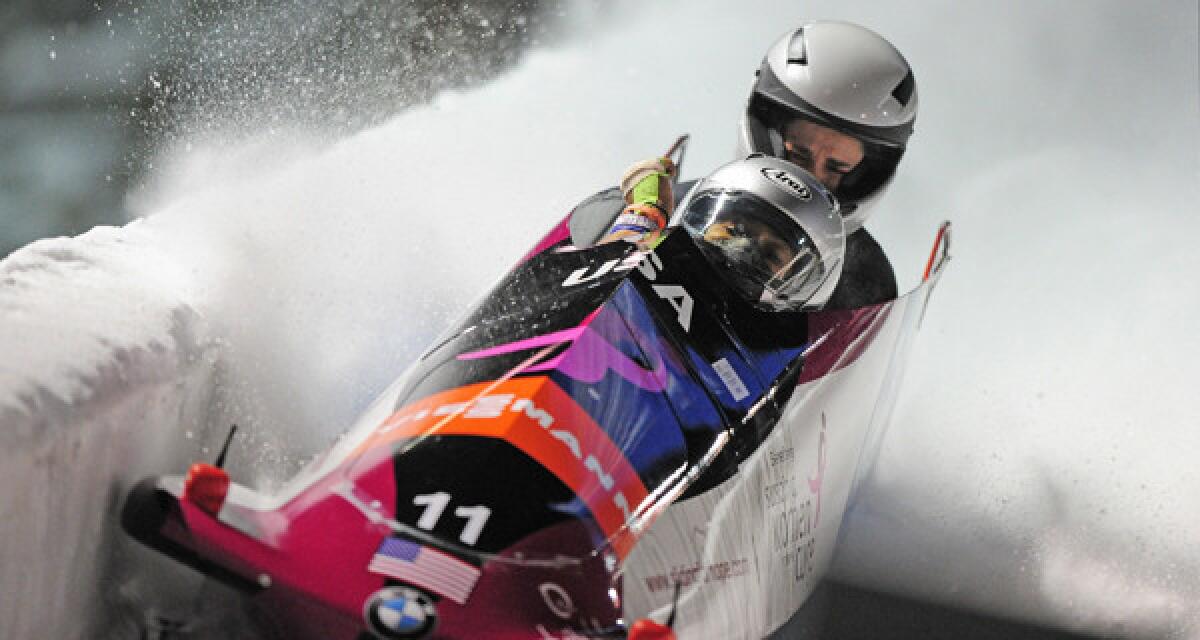U.S. Olympic hopefuls turn to crowd-funding to pay way to Sochi

- Share via
Her shoes are made special, with scores of tiny spikes to grip the ice, and they never seem to last long enough.
The steel runners for her sled cost more than $6,000 and the airlines charge $100 each way to carry her equipment to international races.
When American bobsled pilot Jazmine Fenlator sat down and calculated her expenses leading up to the 2014 Sochi Olympics — eight months of training and competition — the numbers added up quickly.
“I’m in debt,” she said. “People don’t realize.”
Unlike athletes in most other countries, U.S. Olympians receive no direct government funding. Some — the Shaun Whites and Lindsey Vonns — can earn prize money and attract big endorsement deals.
Far more live hand-to-mouth, working side jobs to supplement the modest stipends they get from their national governing bodies. Fenlator — the eighth-ranked female slider in the world last season — estimates she will spend $80,000 in her quest to reach the Games.
“I still have regular-people bills too,” she said. “Things like student loans and my cellphone.”
So the 28-year-old has joined a growing number of American athletes trying something new to stay afloat.
——
The idea began with a guy named Bill Kerig who played hockey as a kid, knocking on doors in the neighborhood, selling chocolate bars to raise money for his team.
Kerig grew up to be a writer and documentary filmmaker. Working on a movie about U.S. ski jumpers, he turned to crowd-funding to raise $26,000 for production costs.
Crowd-funding has been around in one form or another since the 1700s but has gained popularity among startups and filmmakers since the advent of the Internet.
It works like this: An entrepreneur goes online with his project, hoping to attract financial support from a wide array of individuals who climb aboard as donors or, in some cases, shareholders.
“It dawned on me after I used crowd-funding for my film,” Kerig recalls. “Where was the crowd-funding for athletes?”
In the fall of 2012, he launched RallyMe.com as a specific kind of crowd-funding site, and he forged relationships with the governing bodies that oversee winter sports ranging from skiing to skeleton.
Lindsey Van — one of the ski jumpers in his film — served as a test case. She set out to raise $13,000 and finished with more than $20,000, which allowed her to quit work and focus on training.
“I was thrilled that so many people supported me,” Van said by email from a competition in Japan. “And lots of people I had never met.”
Kerig had his proof of concept — plenty of donors out there willing to contribute to U.S. Olympians in the less-glamorous sports. Next, he had to persuade athletes to give it a try.
——
The notion of crowd-funding wasn’t entirely new to Alyson Dudek. The short-track speedskater had heard of athletes raising money on all-purpose sites such as GoFundMe and indiegogo.
So when speedskating officials announced a partnership with RallyMe, Dudek jumped in, saying: “I’m not going to turn down anyone’s help.”
Athletes begin by creating a page on the website, adding photographs, a description of themselves and even videos. Kerig asks them to list a dollar amount they hope to meet within 30 to 90 days.
In return for donations, they can offer gifts ranging from autographed photographs to VIP passes for major competitions.
But as Dudek quickly learned, the tough part is getting people to know about the campaign. Through her first month or so, she raised only $3,598 of her $15,000 goal.
“It’s really difficult,” she said. “It takes talking to family and friends and having them spread the word.”
Others have been more successful.
Sugar Todd, a speedskater, used GoFundMe to raise $5,864 so her parents could accompany her to Sochi.
Teenage brothers Danny and Drew Duffy gathered $52,601 on RallyMe to cover expenses as they rise up the ranks of American skiers.
The U.S. women’s ski jumping team mounted a group effort that brought in 118 boosters for a total of $32,950.
The most successful athletes have used other social media to promote their fundraising campaigns.
“I’ve kind of struggled,” bobsledder Elana Meyers said after raising only $738. “To get it out there, I’m using my Twitter followers and Facebook followers.”
——
The 45-second video has Fenlator in the weight room and running sprints, screaming through an icy turn and hugging a teammate at the finish line.
After that, her page offers a brief personal history that includes a story about her family being left homeless after Hurricane Irene hit the East Coast in 2011.
“I wanted to tell my story,” she said.
She sent her boosters postcards from a World Cup race or, for a larger donation, offered them a visit to the Olympic bobsled track in Lake Placid, N.Y.
The campaign ultimately raised $2,645. That wasn’t as much as she had hoped for, but it helped cover recent training in Calgary, Canada, which has an ice house for sliders to practice their push starts.
The facility charges $250 an hour and she racked up several thousand dollars in living and travel costs.
Facing more expenses with the onset of the World Cup season, Fenlator is keeping an eye on the bottom line.
“Every dollar helps,” she says. “Every penny helps.”
Twitter: @LATimesWharton
atimes.com”>david.wharton@latimes.com
Twitter: @LATimesWharton
More to Read
Go beyond the scoreboard
Get the latest on L.A.'s teams in the daily Sports Report newsletter.
You may occasionally receive promotional content from the Los Angeles Times.











